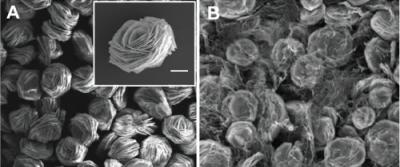A team of researchers at the Indian Institute of Science Education and Research presents a promising anode material for lithium-ion batteries, by incorporating unique 3D cobalt oxide microstructures into a reduced graphene oxide composite.

Metal oxides present a potential alternative to conventional graphite anodes and Li alloys. Cobalt oxide (CoO) has particularly promising properties, namely a high specific capacity and excellent cycling stability against lithium. However, particle aggregation and volume expansion have thus far restricted its candidacy as an appropriate anode material. Merging CoO into a graphene hydrogel, which acts as a mechanically stable 3D support, the researchers eliminate the problem of volume expansion. Furthermore, the completely interconnected hybrid material presents improved conductivity.
A hydrothermal technique is used to obtain these uniform microsctructures (with an interesting rose-shaped morphology). These are then anchored on reduced graphene oxide (rGO) sheets for incorporation into a graphene hydrogel (GHG). Comparing the two materials as Li-ion battery anodes, the CoO-GHG exhibited superior electrochemical performance. The unique morphology of the CoO structures and their cross-linking with rGO sheets enables shorter Li+diffusion, and removes common problems caused by volume expansion during lithiation/delithiation.
In October 2015, scientists showed that graphene and cobalt make for a powerful catalyst for fuel cells.